Research Trend of the Unified Theory of Acceptance and Use of Technology Theory: A Bibliometric Analysis
Abstract
:1. Introduction
2. Literature Review
3. Data Sources and Research Methods
3.1. Bibliometric Data Sources
3.2. Research Methods
3.2.1. Research Software
3.2.2. Research Plan
- RQ1.
- What is the current research status of the UTAUT?
- RQ2.
- What is the distribution of the main research forces in the field of the UTAUT?
- RQ3.
- What are the research hotspots in the field of the UTAUT?
- RQ4.
- What are the future research priorities and directions in the field of the UTAUT?
4. Bibliometric Results Analysis
4.1. Literature Description Features Analysis
4.2. Annual Scientific Yield Analysis
4.3. Main Research Journals Analysis
4.4. Main Research Author Analysis
4.5. Highly Cited Literature Analysis
4.6. National Cooperation and Document Issuance Analysis
4.7. Research Topics and Future Research Directions
5. Conclusions
Author Contributions
Funding
Institutional Review Board Statement
Informed Consent Statement
Data Availability Statement
Conflicts of Interest
References
- IDC Asia/Pacific Unveils Its Top ICT Predictions for 2022 and Beyond at IDC FutureScape. Available online: https://www.idc.com/getdoc.jsp?containerId=prAP48347921 (accessed on 10 October 2021).
- Fishbein, M.A.; Ajzen, I. Belief, attitude, intention and behavior: An Introduction to theory and research. addison-wesley, reading ma. Philos. Rhetor. 1977, 41, 842–844. [Google Scholar]
- Davis, F.D.; Bagozzi, R.P.; Warshaw, P.R. User acceptance of computer technology: A comparison of two theoretical models. Manag. Sci. 1989, 35, 982–1003. [Google Scholar] [CrossRef] [Green Version]
- Venkatesh, V.; Davis, F.D. A theoretical extension of the technology acceptance model: Four longitudinal field studies. Manag. Sci. 2000, 46, 186–204. [Google Scholar] [CrossRef] [Green Version]
- Venkatesh, V.; Morris, M.G.; Davis, G.B.; Davis, F.D. User acceptance of information technology: Toward a unified view. MIS Q. 2003, 27, 425–478. [Google Scholar] [CrossRef] [Green Version]
- Amrouni, K.I.; Arshah, R.A. A bibliometric analysis of the E-government studies with (UTAUT). In Proceedings of the FGIC 2nd Conference on Governance and Integrity, Kuantan, Malaysia, 22–27 August 2019. [Google Scholar]
- Dwivedi, Y.K.; Mustafee, N.; Carter, L.D.; Williams, M.D. A bibliometric comparision of the usage of two theories of IS/IT acceptance (TAM and UTAUT). In Proceedings of the 16th Americas Conference on Information Systems, AMCIS 2010, Lima, Peru, 12–15 August 2010. [Google Scholar]
- Taneja, B.; Bharti, K. Mapping unified theory of acceptance and use of technology (UTAUT) 2: A taxonomical study using bibliometric visualisation. Foresight 2021. ahead of print. [Google Scholar] [CrossRef]
- Czerwinska, M. Analysis of the use of the UTAUT model for modeling the information technology acceptance process. J. Comput. Sci. Inst. 2020, 17, 417–420. [Google Scholar] [CrossRef]
- Xu, Z.; Ge, Z.; Wang, X.; Skare, M. Bibliometric analysis of technology adoption literature published from 1997 to 2020. Technol. Forecast. Soc. Chang. 2021, 170, 120896. [Google Scholar] [CrossRef]
- Williams, M.D.; Rana, N.P.; Dwivedi, Y.K. The unified theory of acceptance and use of technology (UTAUT): A literature review. J. Enterp. Inf. Manag. 2015, 28, 443–488. [Google Scholar] [CrossRef] [Green Version]
- Tamilmani, K.; Rana, N.P.; Wamba, S.F.; Dwivedi, R. The extended unified theory of acceptance and use of technology (UTAUT2): A systematic literature review and theory evaluation. Int. J. Inf. Manag. 2021, 57, 102269. [Google Scholar] [CrossRef]
- Venkatesh, V.; Thong, J.Y.L.; Xu, X. Unified theory of acceptance and use of technology: A synthesis and the road ahead. J. Assoc. Inf. Syst. 2016, 17, 328–376. [Google Scholar] [CrossRef]
- Williams, M.D.; Rana, N.P.; Dwivedi, Y.K. A bibliometric analysis of articles citing the unified theory of acceptance and use of technology. In Information Systems Theory; Springer: New York, NY, USA, 2012; pp. 37–62. [Google Scholar]
- Aria, M.; Cuccurullo, C. bibliometrix: An R-tool for comprehensive science mapping analysis. J. Informetr. 2007, 11, 959–975. [Google Scholar] [CrossRef]
- Chen, C.M. CiteSpace II: Detecting and visualizing emerging trends and transient patterns in scientific literature. J. Am. Soc. Inf. Sci. Technol. 2006, 57, 359–377. [Google Scholar] [CrossRef] [Green Version]
- Zhou, T.; Lu, Y.; Wang, B. Integrating TTF and UTAUT to explain mobile banking user adoption. Comput. Hum. Behav. 2010, 26, 760–767. [Google Scholar] [CrossRef]
- Palau-Saumell, R.; Forgas-Coll, S.; Sanchez-Garcia, J.; Robres, E. User acceptance of mobile Apps for restaurants: An expanded and extended UTAUT-2. Sustainability 2019, 11, 1210. [Google Scholar] [CrossRef] [Green Version]
- Dwivedi, Y.K.; Rana, N.P.; Jeyaraj, A.; Clement, M.; Williams, M.D. Re-examining the unified theory of acceptance and use of technology (UTAUT): Towards a Revised Theoretical Model. Inf. Syst. Front. 2019, 21, 719–734. [Google Scholar] [CrossRef] [Green Version]
- Oliveira, T.; Faria, M.; Thomas, M.A.; Popovič, A. Extending the understanding of mobile banking adoption: When UTAUT meets TTF and ITM. Int. J. Inf. Manag. 2014, 34, 689–703. [Google Scholar] [CrossRef]
- Rana, N.P.; Dwivedi, Y.K.; Williams, M.D.; Weerakkody, V. Adoption of online public grievance redressal system in India: Toward developing a unified view. Comput. Human Behavior. 2016, 59, 265–282. [Google Scholar] [CrossRef]
- Venkatesh, V.; Thong, J.Y.L.; Xu, X. Consumer acceptance and use of information technology: Extending the Unified Theory of Acceptance and Use of Technology. MIS Q. 2012, 36, 157–178. [Google Scholar] [CrossRef] [Green Version]
- Wang, Y.; Wu, M.; Wang, H. Investigating the determinants and age and gender differences in the acceptance of mobile learning. Br. J. Educ. Technol. 2009, 40, 92–118. [Google Scholar] [CrossRef]
- Martins, C.; Oliveira, T.; Popovic, A. Understanding the Internet banking adoption: A unified theory of acceptance and use of technology and perceived risk application. Int. J. Inf. Manag. 2014, 34, 1–13. [Google Scholar] [CrossRef]
- Van Raaij, E.M.; Schepers, J.J.L. The acceptance and use of a virtual learning environment in China. Comput. Educ. 2008, 50, 838–852. [Google Scholar] [CrossRef]
- Thong, J.Y.L.; Venkatesh, V.; Xu, X.; Hong, S.-J.; Tam, K.Y. Consumer acceptance of personal information and communication technology services. IEEE Trans. Eng. Manag. 2011, 58, 613–625. [Google Scholar] [CrossRef]
- Palos-Sanchez, P.R.; Correia, M.B.; Saura, J.R. An empirical examination of adoption of mobile applications in Spain and Portugal, based in UTAUT. Int. J. Mob. Commun. 2019, 17, 579–603. [Google Scholar] [CrossRef]
- Tomczyk, S.; Barth, S.; Schmidt, S.; Muehlan, H. Utilizing health behavior change and technology acceptance models to predict the adoption of COVID-19 contact tracing Apps: Cross-sectional Survey Study. J. Med Internet Res. 2021, 23, e254475. [Google Scholar] [CrossRef] [PubMed]
- Hew, J.; Lee, V.; Ooi, K.; Wei, J. What catalyses mobile apps usage intention: An empirical analysis. Ind. Manag. Data Syst. 2015, 115, 1269–1291. [Google Scholar] [CrossRef]
- Nisha, N.; Iqbal, M.; Rifat, A. The changing paradigm of health and mobile phones: An innovation in the health care system. J. Glob. Inf. Manag. 2019, 27, 19–46. [Google Scholar] [CrossRef]
- Obienu, A.C.; Amadin, F.I. User acceptance of learning innovation: A structural equation modelling based on the GUAM framework. Educ. Inf. Technol. 2021, 26, 2091–2123. [Google Scholar] [CrossRef]
- Chang, I.; Hwang, H.; Hung, W.; Li, Y. Physicians’ acceptance of pharmacokinetics-based clinical decision support systems. Expert Syst. Appl. 2007, 33, 296–303. [Google Scholar] [CrossRef]
- Sohn, K.; Kwon, O. Technology acceptance theories and factors influencing artificial Intelligence-based intelligent products. Telemat. Inform. 2020, 47, 101324. [Google Scholar] [CrossRef]
- Sagnier, C.; Loup-Escande, E.; Vallery, G. Technology acceptance of virtual reality: A review. Trav. Hum. 2019, 82, 183–212. [Google Scholar] [CrossRef]
- Merhi, M.; Hone, K.; Tarhini, A. A cross-cultural study of the intention to use mobile banking between Lebanese and British consumers: Extending UTAUT2 with security, privacy and trust. Technol. Soc. 2019, 59, 101151. [Google Scholar] [CrossRef]
- Mensah, I.K. Factors Influencing the Intention of University Students to Adopt and Use E-Government Services: An Empirical Evidence in China. SAGE Open 2019, 9, 2158244019855823. [Google Scholar] [CrossRef] [Green Version]
- Nistor, N.L.; Lerche, T.; Weinberger, A.; Ciobanu, C.; Heymann, O. Towards the integration of culture into the unified theory of acceptance and use of technology. Br. J. Educ. Technol. 2014, 45, 36–55. [Google Scholar] [CrossRef] [Green Version]
- Jang, W.W.; Byon, K.K. Antecedents and consequence associated with esports gameplay. Int. J. Sports Mark. Spons. 2020, 21, 1–22. [Google Scholar] [CrossRef]
- Rahi, S.; Mansour, M.M.O.; Alghizzawi, M.; Alnaser, F.M. Integration of UTAUT model in internet banking adoption context the mediating role of performance expectancy and effort expectancy. J. Res. Interact. Mark. 2019, 13, 411–435. [Google Scholar] [CrossRef]
- Giovanis, A.; Assimakopoulos, C.; Sarmaniotis, C. Adoption of mobile self-service retail banking technologies: The role of technology, social, channel and personal factors. Int. J. Retail Distrib. Manag. 2019, 47, 894–914. [Google Scholar] [CrossRef]
- Aldossari, M.Q.; Sidorova, A. Consumer acceptance of Internet of Things (IoT): Smart Home Context. J. Comput. Inf. Syst. 2020, 60, 507–517. [Google Scholar] [CrossRef]
- Xu, X.; Thong, J.Y.L.; Tam, K.Y. Winning back technology disadopters: Testing a technology readoption model in the context of mobile internet services. J. Manag. Inf. Systems 2017, 34, 102–140. [Google Scholar] [CrossRef]
- Tamilmani, K.; Rana, N.P.; Dwivedi, Y.K. Consumer Acceptance and Use of Information Technology: A Meta-Analytic Evaluation of UTAUT2. Inf. Syst. Front. 2020, 23, 987–1005. [Google Scholar] [CrossRef]
- Brown, S.A.; Dennis, A.R.; Venkatesh, V. Predicting collaboration technology use: Integrating technology adoption and col laboration research. J. Manag. Inf. Systems 2010, 27, 9–53. [Google Scholar] [CrossRef]
- Lee, S.W.; Sung, H.J.; Jeon, H.M. Determinants of continuous intention on food delivery Apps: Extending UTAUT2 with information quality. Sustainability 2019, 11, 3141. [Google Scholar] [CrossRef] [Green Version]
- Kuciapski, M. A model of mobile technologies acceptance for knowledge transfer by employees. J. Knowl. Manag. 2017, 21, 1053–1076. [Google Scholar] [CrossRef]
- Criollo, C.S.; Lema, M.; Gonzalez, M.S.; Jaramillo-Alcazar, A.; Guerrero-Arias, A.; Lujan-Mora, S. Exploring the technological acceptance of a mobile learning tool used in the teaching of an indigenous language. PEERJ Comput. Sci. 2021, 7, e550. [Google Scholar] [CrossRef] [PubMed]
- Shachak, A.; Kuziernsky, C.; Petersen, C. Beyond TAM and UTAUT: Future directions for HIT implementation research. J. Biomed. Inform. 2019, 100, 103315. [Google Scholar] [CrossRef]
- Rabu, S.N.A.; Hussin, H.; Bervell, B. QR code utilization in a large classroom: Higher education students’ initial perceptions. Educ. Inf. Technol. 2019, 24, 359–384. [Google Scholar] [CrossRef]
- Raigoso, D.; Cespedes, N.; Cifuentes, C.A.; Del-Ama, A.J.; Munera, M. A survey on socially assistive robotics: Clinicians’ and Patients’ perception of a social robot within gait rehabilitation therapies. Brain Sci. 2021, 11, 738. [Google Scholar] [CrossRef]
- Mou, J.; Benyoucef, M. Consumer behavior in social commerce: Results from a meta-analysis. Technol. Forecast. Soc. Chang. 2021, 167, 120734. [Google Scholar] [CrossRef]
- Tai, Y.; Ku, Y. Will stock investors use mobile stock trading? A benefit-risk assessment based on a modified UTAUT Model. J. Electron. Commer. Res. 2013, 14, 67–84. [Google Scholar]
- Nordhoff, S.; Malmsten, V.; van Arem, B.; Liu, P.; Happee, R. A structural equation modeling approach for the acceptance of driverless automated shuttles based on constructs from the unified theory of acceptance and use of Technology and the diffusion of innovation theory. Transp. Res. Part F Traffic Psychol. Behav. 2021, 78, 58–73. [Google Scholar] [CrossRef]
- Maity, M.; Bagchi, K.; Shah, A.; Misra, A. Explaining normative behavior in information technology use. Inf. Technol. People 2019, 32, 94–117. [Google Scholar] [CrossRef]
- IJzerman, R.V.H.; van der Vaart, R.; Evers, A.W.M. Internet-Based cognitive behavioral therapy among psychologists in a medical setting: A survey on implementation. J. Med. Internet Res. 2019, 21, e134328. [Google Scholar] [CrossRef] [PubMed]
- Gansser, O.A.; Reich, C.S. A new acceptance model for artificial intelligence with extensions to UTAUT2: An empirical study in three segments of application. Technol. Soc. 2021, 65, 101535. [Google Scholar] [CrossRef]
- Eckhardt, A.; Laumer, S.; Weitzel, T. Who influences whom? Analyzing workplace referents’ social influence on IT adoption and non-adoption. J. Inf. Technol. 2009, 24, 11–24. [Google Scholar] [CrossRef]
- Kang, M.S.; Im, I.; Hong, S. Testing robustness of UTAUT model: An invariance analysis. J. Glob. Inf. Manag. 2017, 25, 81–97. [Google Scholar] [CrossRef] [Green Version]
- Venkatesh, V. Adoption and use of AI tools: A research agenda grounded in UTAUT. Ann. Oper. Res. 2021, 1–12. [Google Scholar] [CrossRef]
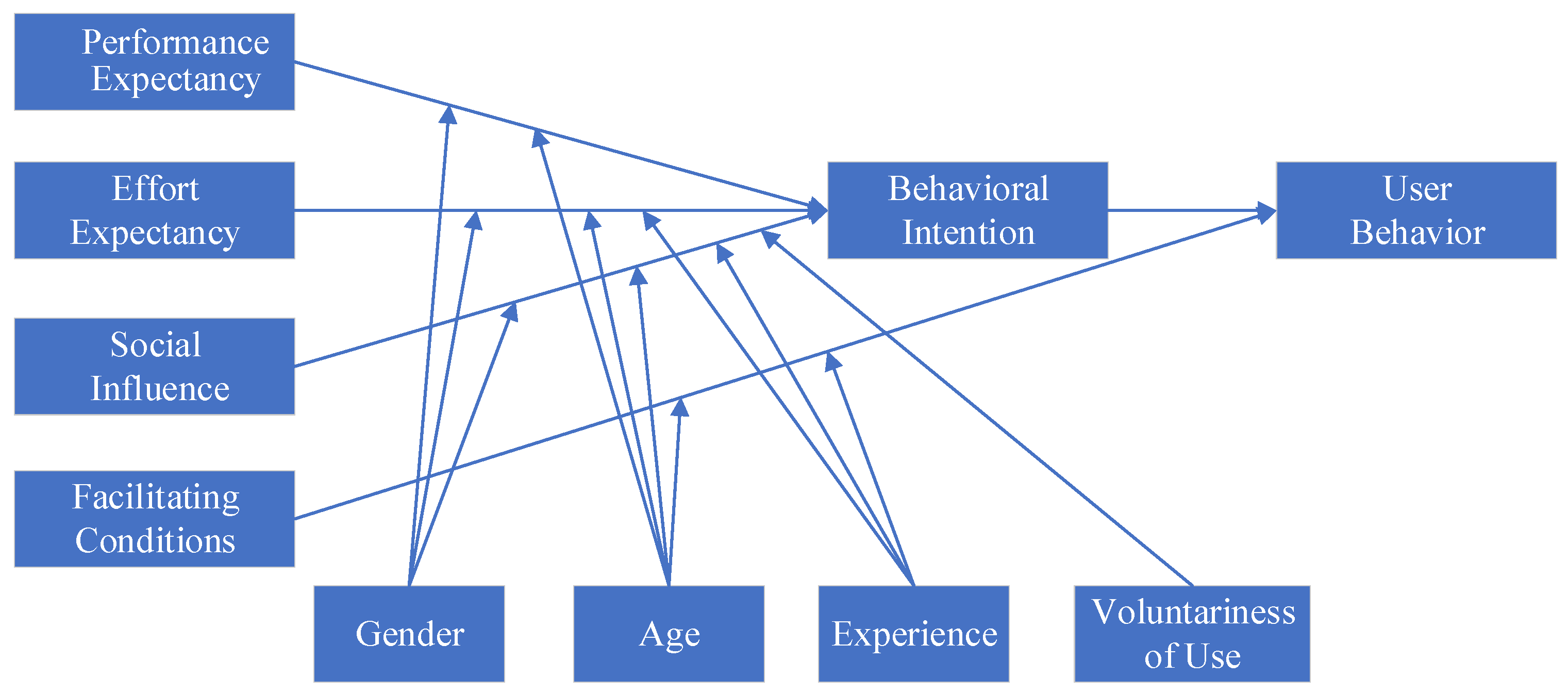
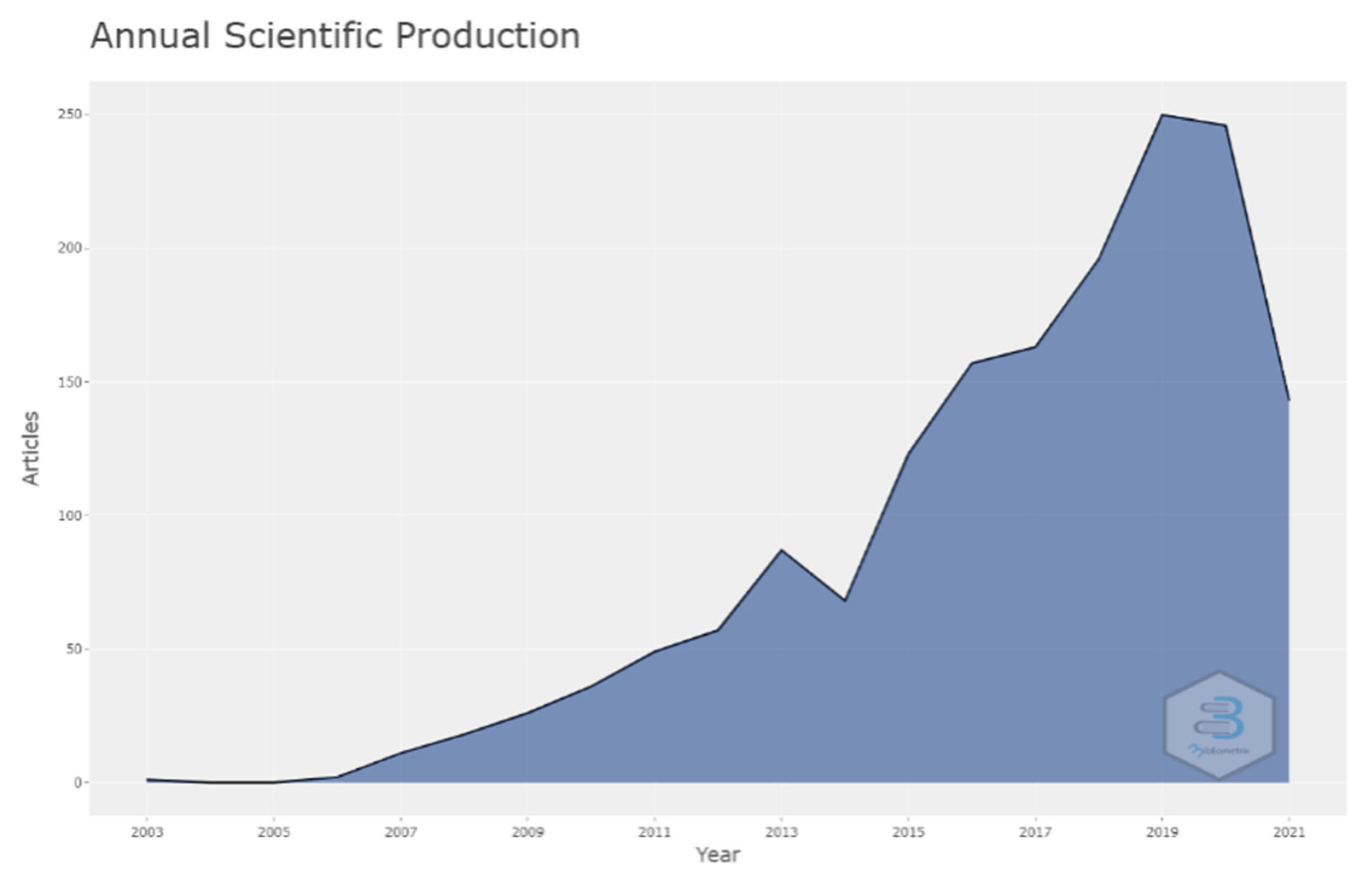

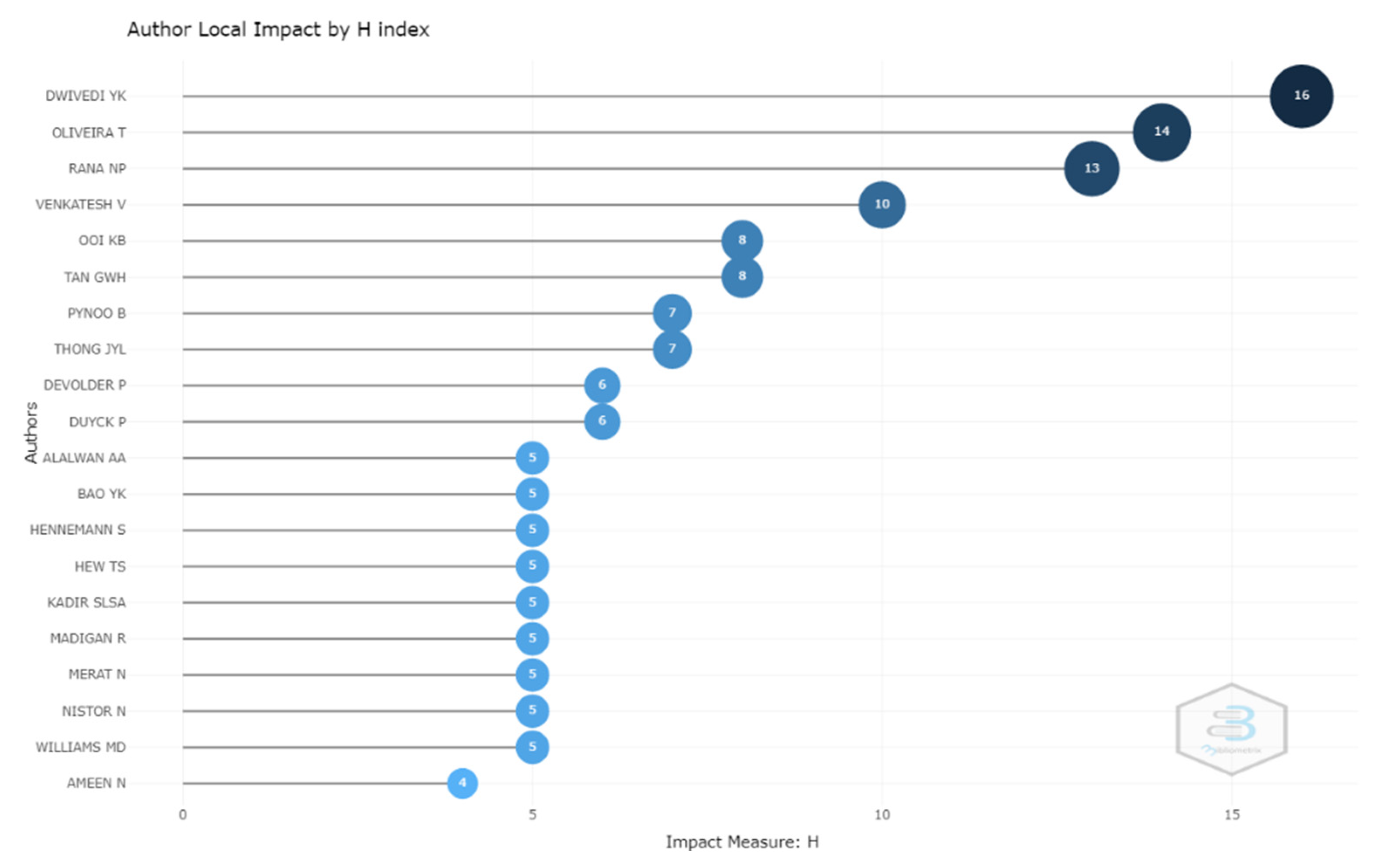
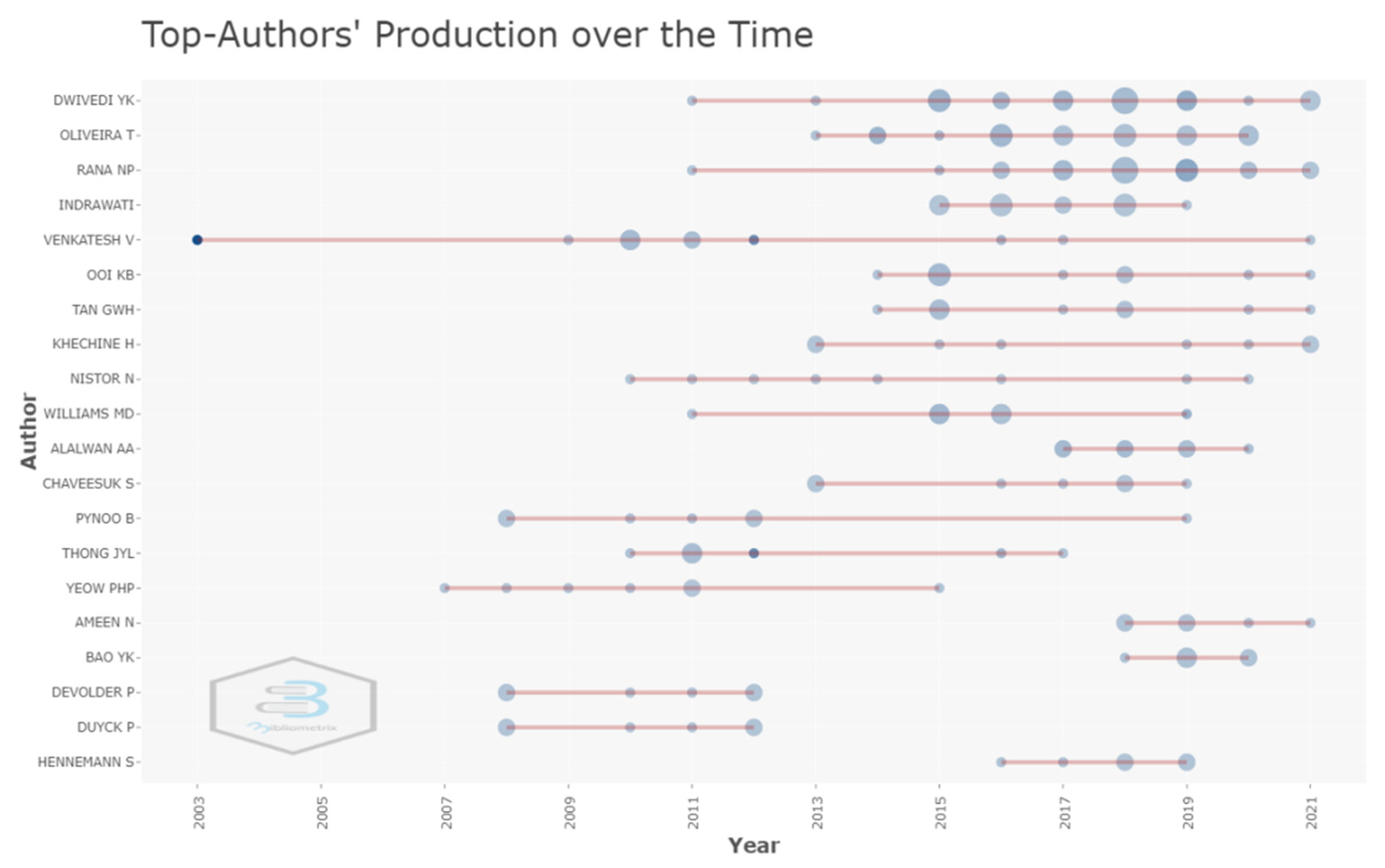
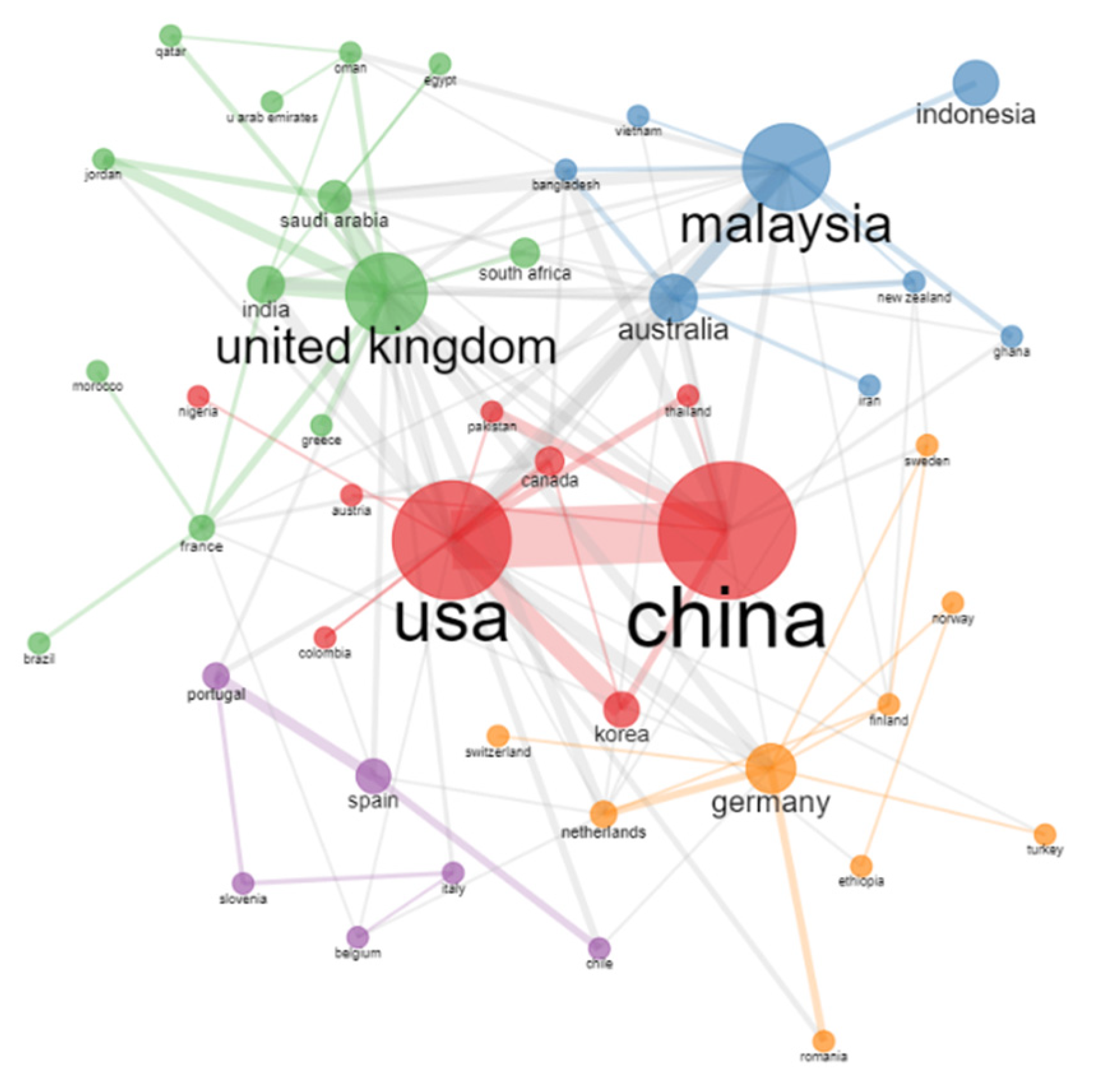
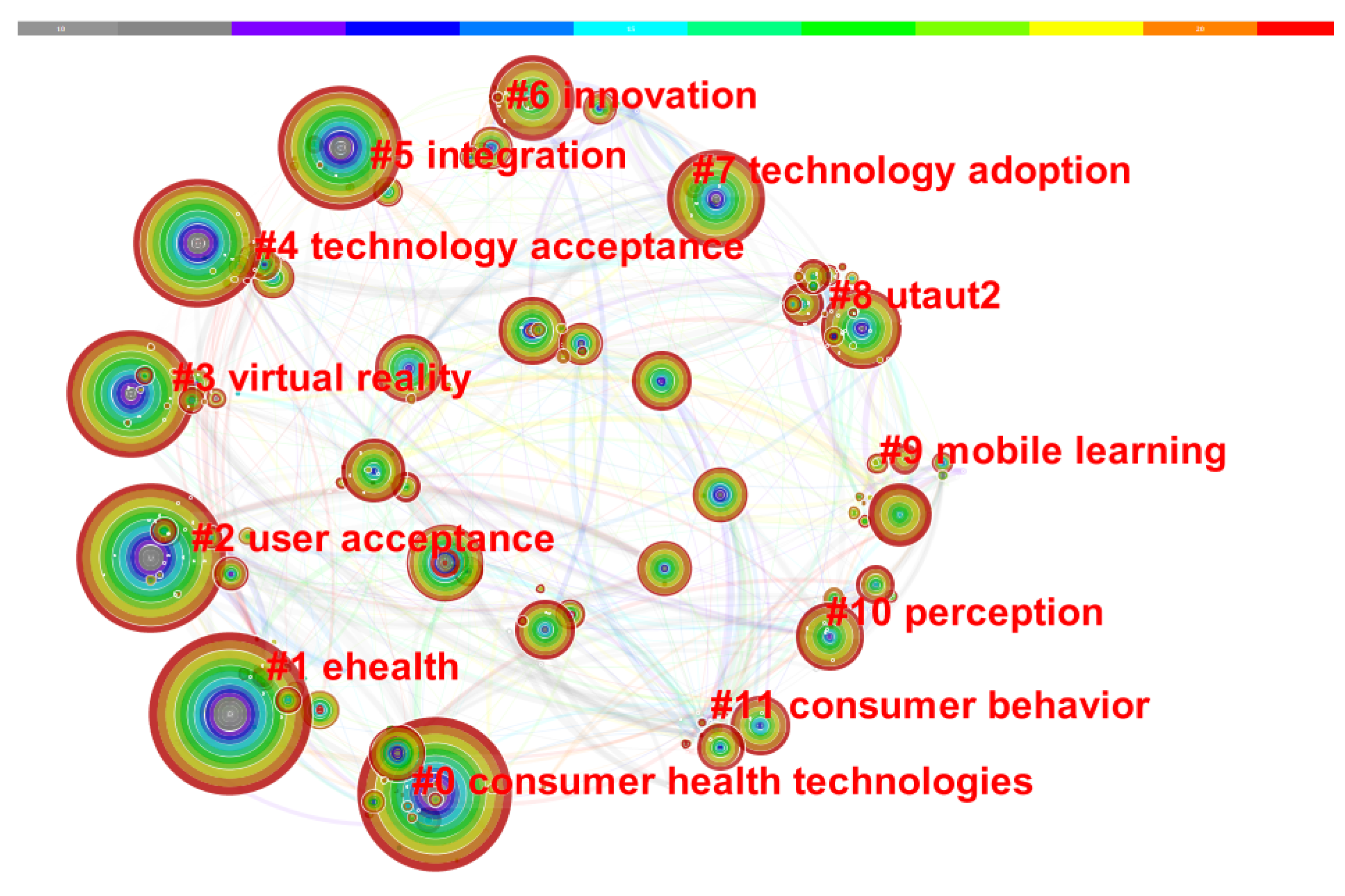

| Description | Results |
|---|---|
| Timespan | 2003–2021 |
| Sources (Journals, Books, etc.) | 844 |
| Documents | 1694 |
| Average years from publication | 4.18 |
| Average citations per document | 26.06 |
| Average citations per year per doc | 3.615 |
| References | 47,237 |
| Keywords Plus (ID) | 1541 |
| Author’s Keywords (DE) | 3908 |
| Authors | 4194 |
| Sources | Rank | Freq | CumFreq | Zone |
|---|---|---|---|---|
| Computers in Human Behavior | 1 | 41 | 41 | Zone 1 |
| Sustainability | 2 | 36 | 77 | Zone 1 |
| International Journal of Information Management | 3 | 31 | 108 | Zone 1 |
| Education and Information Technologies | 4 | 25 | 133 | Zone 1 |
| Behaviour and Information Technology | 5 | 21 | 154 | Zone 1 |
| International Journal of Mobile Communications | 6 | 18 | 172 | Zone 1 |
| Journal of Medical Internet Research | 7 | 18 | 190 | Zone 1 |
| Advanced Science Letters | 8 | 16 | 206 | Zone 1 |
| International Journal of Medical Informatics | 9 | 16 | 222 | Zone 1 |
| Telematics and Informatics | 10 | 16 | 238 | Zone 1 |
| BMC Medical Informatics and Decision Making | 11 | 15 | 253 | Zone 1 |
| Information Development | 12 | 15 | 268 | Zone 1 |
| Information Systems Frontiers | 13 | 14 | 282 | Zone 1 |
| Technology in Society | 14 | 14 | 296 | Zone 1 |
| British Journal of Educational Technology | 15 | 13 | 309 | Zone 1 |
| Computers and Education | 16 | 13 | 322 | Zone 1 |
| International Journal of Environmental Research and Public Health | 17 | 13 | 335 | Zone 1 |
| Industrial Management and Data Systems | 18 | 11 | 346 | Zone 1 |
| Interactive Learning Environments | 19 | 11 | 357 | Zone 1 |
| Journal of Retailing and Consumer Services | 20 | 11 | 368 | Zone 1 |
| Authors | Year | Sources | Titles | Total Citations |
|---|---|---|---|---|
| Venkatesh, V. | 2003 | MIS Quarterly | “User acceptance of information technology: Toward a unified view” | 11,622 |
| Venkatesh, V. | 2012 | MIS Quarterly | “Consumer acceptance and use of information technology: Extending the unified theory of acceptance and use of technology” | 2844 |
| Zhou, T. | 2010 | Computers in Human Behavior | “Integrating TTF and UTAUT to explain mobile banking user adoption” | 559 |
| Wang, Y.S. | 2009 | British Journal of Educational Technology | “Investigating the determinants and age and gender differences in the acceptance of mobile learning” | 484 |
| Martins, C. | 2014 | International Journal of Information Management | “Understanding the internet banking adoption: A unified theory of acceptance and use of technology and perceived risk application” | 419 |
| Van Raaij, E.M. | 2008 | Computers and Education | “The acceptance and use of a virtual learning environment in China” | 399 |
| CHIU, C.M. | 2008 | Information and Management | “Understanding web-based learning continuance intention: The role of subjective task value” | 371 |
| Venkatesh, V. | 2016 | Journal of the Association for Information Systems | “Unified theory of acceptance and use of technology: A synthesis and the road ahead” | 317 |
| Heerink, M. | 2010 | International Journal of Social Robotics | “Assessing acceptance of assistive social agent technology by older adults: the Almere model” | 313 |
| Venkatesh, V. | 2011 | Information Systems Journal | “Extending the two-stage information systems continuance model: Incorporating UTAUT predictors and the role of context” | 291 |
| from | to | Frequency |
|---|---|---|
| CHINA | USA | 37 |
| USA | KOREA | 13 |
| UNITED KINGDOM | INDIA | 12 |
| UNITED KINGDOM | SAUDI ARABIA | 12 |
| USA | MALAYSIA | 12 |
| MALAYSIA | AUSTRALIA | 9 |
| USA | GERMANY | 9 |
| USA | INDIA | 9 |
| CHINA | BANGLADESH | 8 |
| CHINA | PAKISTAN | 8 |
| MALAYSIA | SAUDI ARABIA | 8 |
| UNITED KINGDOM | JORDAN | 8 |
| USA | AUSTRALIA | 8 |
| Cluster # | Cluster Size | Silhouette | Average Year of Formation | Cluster Name | Selected Keywords |
|---|---|---|---|---|---|
| 0 | 42 | 0.901 | 2017 | Consumer health technologies | Smartphone; mobile payment; health; mobile intervention; privacy concern; mobile phone |
| 1 | 42 | 0.817 | 2016 | E-health | Perception; attitude; self-efficacy; antecedent; personal innovativeness; M-health; care; E-health; PLS-SEM; quality; ease mobile application; privacy |
| 2 | 38 | 0.967 | 2011 | User acceptance | information technology; user acceptance; model; usage; extension; impact; banking; perspective; experience; continuance intention |
| 3 | 35 | 0.926 | 2011 | Virtual reality | behavioral intention; gender; information; education; meta-analysis; intrinsic motivation; decision; belief |
| 4 | 34 | 0.931 | 2013 | Technology acceptance | Acceptance; technology; perceived usefulness; perceived ease; TAM; E-government; developing country; task–technology fit; barrier |
| 5 | 32 | 0.89 | 2016 | Integration | Online; consumer adoption; teacher; facilitating condition; customer satisfaction; purchase intention |
| 6 | 32 | 0.887 | 2016 | Innovation | Internet; innovation; innovativeness; success mobile commerce; electronic commerce |
| 7 | 30 | 0.872 | 2013 | Technology adoption | Intention; system; technology adoption; social influence; internet banking; consumer; information system |
| 8 | 28 | 0.873 | 2013 | UTAUT2 | UTAUT2; trust; perceived risk; structural equation model; commerce; acceptance model; culture; hedonic motivation |
| 9 | 27 | 0.82 | 2013 | Mobile learning | higher education; E-commerce; M-learning empirical examination; performance; framework; usage intention; E-learning |
| 10 | 26 | 0.964 | 2012 | Perception | Perception; attitude; antecedent; ease |
| 11 | 25 | 0.74 | 2014 | Consumer behavior | Service; behavior; consumer acceptance; initial trust; age; planned behavior; consumer behavior |
Publisher’s Note: MDPI stays neutral with regard to jurisdictional claims in published maps and institutional affiliations. |
© 2021 by the authors. Licensee MDPI, Basel, Switzerland. This article is an open access article distributed under the terms and conditions of the Creative Commons Attribution (CC BY) license (https://creativecommons.org/licenses/by/4.0/).
Share and Cite
Wang, J.; Li, X.; Wang, P.; Liu, Q.; Deng, Z.; Wang, J. Research Trend of the Unified Theory of Acceptance and Use of Technology Theory: A Bibliometric Analysis. Sustainability 2022, 14, 10. https://doi.org/10.3390/su14010010
Wang J, Li X, Wang P, Liu Q, Deng Z, Wang J. Research Trend of the Unified Theory of Acceptance and Use of Technology Theory: A Bibliometric Analysis. Sustainability. 2022; 14(1):10. https://doi.org/10.3390/su14010010
Chicago/Turabian StyleWang, Jing, Xinchun Li, Peng Wang, Quanlong Liu, Zhiwen Deng, and Jingzhi Wang. 2022. "Research Trend of the Unified Theory of Acceptance and Use of Technology Theory: A Bibliometric Analysis" Sustainability 14, no. 1: 10. https://doi.org/10.3390/su14010010
APA StyleWang, J., Li, X., Wang, P., Liu, Q., Deng, Z., & Wang, J. (2022). Research Trend of the Unified Theory of Acceptance and Use of Technology Theory: A Bibliometric Analysis. Sustainability, 14(1), 10. https://doi.org/10.3390/su14010010






